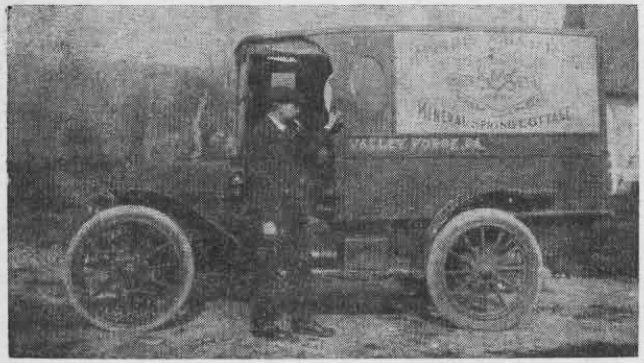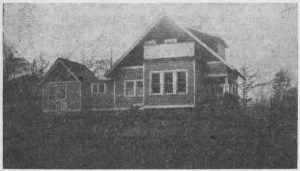 When Morris Abner Barr came to Wayne from Royersford to visit your columnist he brought with him a number of pictures, three of which are reproduced in this week’s column. Others will appear next week.
When Morris Abner Barr came to Wayne from Royersford to visit your columnist he brought with him a number of pictures, three of which are reproduced in this week’s column. Others will appear next week.
Many old timers in this section recall Mr. Barr as he appears in the first picture, when he distributed his bottled waters throughout the Philadelphia suburban area.
To those among us who are accustomed only to the streamlined automobiles of the present, this picture has a very quaint look indeed. As a matter of fact, it was a bit “different” even at the time the picture was taken, since it was an old Autocar touring car converted into a truck. It must have been a sturdy affair, for Mr. Barr tells us that in the year 1917 alone, more than 11,000 gallons of alkaline mineral water from Valley Forge Mineral Springs were delivered from it.
 The second picture shows the first cottage built by Mr. Barr in 1914 when, as an obscure Ardmore carpenter, he had $800 to spend on the project of erecting a simple little house near historic Valley Forge. According to an article published in 1917 in the ”The Daily Republican” of Phoenixville, “the careful construction and the natural mountainous beauty of the background of the little house tucked against a huge hill, quickly found for it a tenant. That first tenant was Frank Bean, now a resident of Norristown, whose name and that of his wife will go down in history of one of the greatest natural springs in the world”. For it was Mrs. Bean who first discovered the medicinal qualities of the water which gushed from a spring in the cellar of the new house the family was occupying.
The second picture shows the first cottage built by Mr. Barr in 1914 when, as an obscure Ardmore carpenter, he had $800 to spend on the project of erecting a simple little house near historic Valley Forge. According to an article published in 1917 in the ”The Daily Republican” of Phoenixville, “the careful construction and the natural mountainous beauty of the background of the little house tucked against a huge hill, quickly found for it a tenant. That first tenant was Frank Bean, now a resident of Norristown, whose name and that of his wife will go down in history of one of the greatest natural springs in the world”. For it was Mrs. Bean who first discovered the medicinal qualities of the water which gushed from a spring in the cellar of the new house the family was occupying.
In constructing the house it had been necessary for Mr. Barr to utilize this spring for the water supply, since his simple budget of $800 did not permit the piping of water all the way from Phoenixville. Two weeks after the Bean family had moved in, Mr. Barr came to finish some minor work on it.
“It was this casual, unheralded visit of Morris Barr”, according to the Daily Republican, “that was the beginning of the great business now operated at these unique springs”. For on this occasion Mrs. Bean told him of the improvement in her general health even in the short time the family had lived there. This improvement she attributed entirely to her use of the water from the spring. Her husband’s neuritis had also disappeared to a great extent.
Following that visit Mr. Barr began the steady use of the spring water in his own home in Ardmore. And when the neighbors heard of the remarkable water, “there was soon a steady stream of visitors to the Bean home to secure the “better than medicine water”.
As the demand for water increased, Mr. Barr took up the question of making a commercial venture of its distribution. But this proved a more serious business than the new owner had anticipated, with much red tape involved in inspections on the part of the State Department of Health. Again to quote “The Daily Republican”, Surveys of every inch of the Treasure Farm – chemical analysis of each spring on the Treasure Farm – covering a period of two years, were made under the direction of Dr. Samuel G. Dixon, of the State Board of Health of Pennsylvania. Photographs of the place were taken from every angle, inspected at Harrisburg, and kept on record there.”
After all this an extensive questionnaire had to be filled out by Mr. Barr. When this was done to the satisfaction of the State Department of Health, Mr. Barr was granted permission to build his plant, including a special vault at the cost of $4,500 and the installation of a bottle washing machine for an additional $1,250, figures which would doubtless be tripled in similar work done today.
 The last picture shows the completed building, much as it looks today. Especially interesting is the entrance wall, which was the last construction work done on the property by Mr. Barr himself. The story of the designing of this wall by Mr. Barr, and the stones that went into it, will be told in next week’s column.
The last picture shows the completed building, much as it looks today. Especially interesting is the entrance wall, which was the last construction work done on the property by Mr. Barr himself. The story of the designing of this wall by Mr. Barr, and the stones that went into it, will be told in next week’s column.
